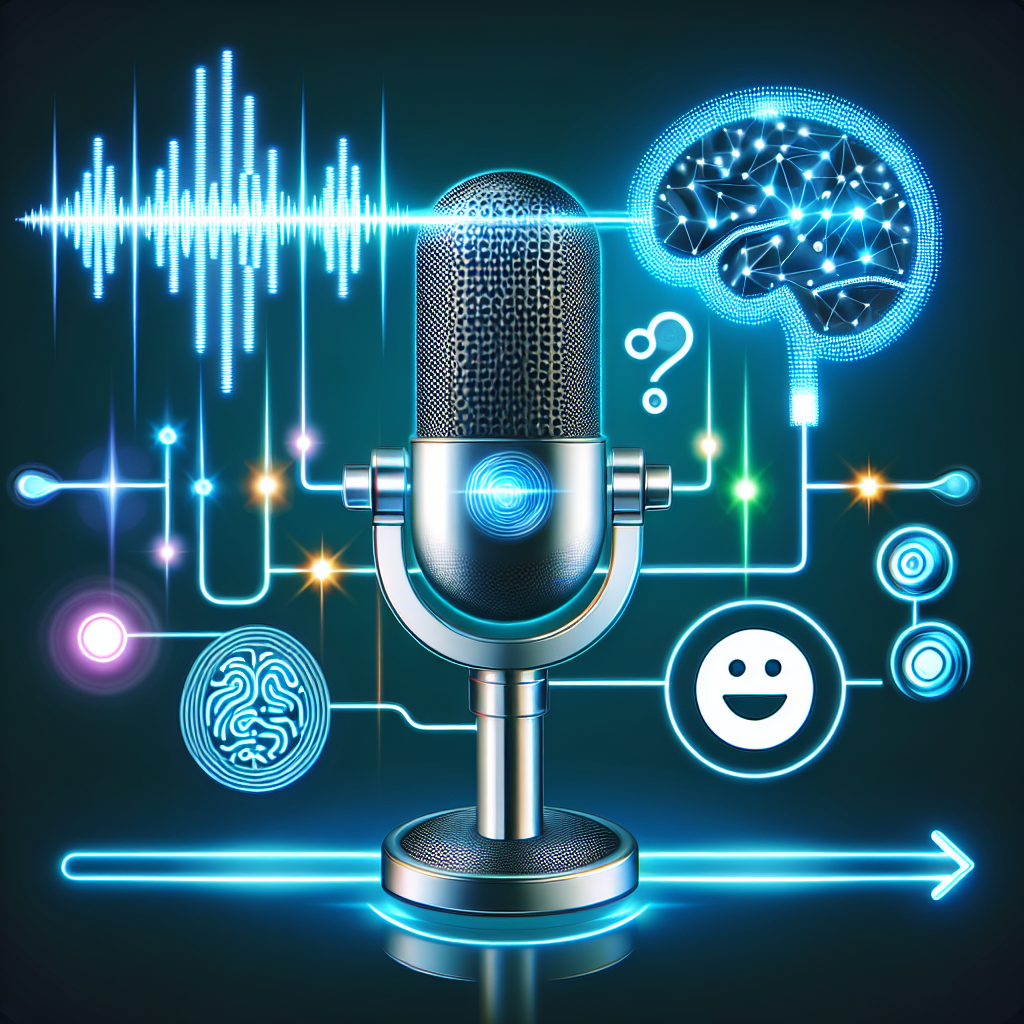
In a world fast-paced and increasingly digital, businesses are in a constant race towards improved operational efficiency and customer engagement. One such avenue is voice-based customer analytics, which involves harnessing voice data, using advanced algorithms to understand and predict customer satisfaction levels in real-time. Let's delve into this fascinating technology and its implications.

When customers interact with a company, they leave behind traces of valuable vocal information. Technologies such as speech recognition, natural language processing (NLP), and machine learning can sift through this data, converting raw vocal cues into usable insights.
Voice-based customer analytics uses specialized algorithms that evaluate a series of voice features such as tone, pitch, and speed. This technology has evolved to a point where it can accurately understand the customer's sentiment, evaluate their emotional state, deeper intentions, and more. This treasure trove of information can serve as an invaluable tool for predicting customer satisfaction in near real-time.
Simply put, the implications of real-time voice-based customer satisfaction predictions are immense for customer service initiatives. It allows companies to accurately gauge the customer's satisfaction during the call, and immediate action can be taken if the analytics predict high levels of dissatisfaction. This instant resolution can immensely improve the overall user experience, boosting brand perception and loyalty.
In conclusion, voice-based customer analytics can offer tremendous advantages in terms of predicting and improving customer satisfaction levels. By incorporating this technology, businesses can be poised to offer superlative customer service, becoming more attuned to their customers' needs, fostering a stronger relationship and a more profound understanding of their consumer base.
There's no denying that we are in an era where customer satisfaction has taken center stage in the realm of business strategy. As the paradigm shifts towards a more customer-centric market, the importance of understanding customer sentiments cannot be overstated. Leading this transformative front is the rise of voice-based customer satisfaction prediction in real-time, an innovation powered by advanced Artificial Intelligence (AI) and Machine Learning (ML) technologies.
The backbone of voice-based customer satisfaction prediction is primarily recognizing, comprehending, and analyzing the nuances of human speech pattern. To accomplish this, it employs three cutting-edge technologies: Natural Language Processing (NLP), Sentiment Analysis, and Emotional Recognition Algorithms.
Natural Language Processing, often abbreviated as NLP, is an aspect of AI that focuses on the interaction between humans and computers using the natural language. The ultimate objective of NLP is to read, decipher, understand, and make sense of the human language in a valuable manner. More about NLP.
Building upon NLP, Sentiment Analysis interprets and classifies emotions (positive, negative, and neutral) within voice data, using text analysis, computational linguistics, biometrics, and natural language processing. Sentiment Analysis helps businesses identify customer emotions towards their brand, products, or services, in real time. Learn more about Sentiment Analysis.
Finally, the foundations of AI technology enabling voice analysis would be incomplete without mentioning Emotional Recognition Algorithms. These algorithms analyze subtle cues in the customer's voice, such as tone and pitch, to predict their emotions and satisfaction levels. The analysis goes beyond the words spoken, providing valuable insights into the customer’s emotional state. Find out more here about Emotional Recognition Algorithms.
By skillfully combining these technologies, voice-based customer satisfaction prediction systems can analyze a customer's voice in real time, predict their satisfaction level, and potentially reshape the customer experience landscape by offering tailor-made solutions in an unprecedented manner.
In our ever-evolving digital landscape, real-time analysis in customer service has begun to take center stage, significantly impacting businesses and customers alike. This technology enables immediate interaction analysis, allowing businesses to respond and adapt rapidly in a dynamic customer service environment. This shift has seen a considerable increase in customer satisfaction.

The advantages of real-time analysis in customer service are quintessential. Firstly, it ensures instant deduction of customer satisfaction, potentially predicting the outcome before the interaction ends. This functionality serves vital for service and product improvement. A case study conducted by IBM with SkyBet revealed a 20% improvement in customer satisfaction associated with real-time interaction analytics.
Secondly, real-time analysis allows immediate response to customer's needs, handling their concerns effectively and instantly. In this context, Cisco's report articulates how the company used real-time analytics to reduce customer complaints by 20%, improving their overall customer experience.
Lastly, real-time analytics fosters proactive customer handling, enabling business operations to anticipate customer requirements. This process informs prompt strategy development, further enhancing customer satisfaction and loyalty. The positive effects of proactive customer handling were confirmed by a global study performed by PWC, which reported an impressive 25% increase in customer loyalty with businesses using real-time analytics.
To conclude, tuning our ears to the voice of customers in real-time is a game-changer in today's customer-centric business landscape. Voice-Based Customer Satisfaction Prediction in Real-Time heralds a new era of customer service where businesses deliver exactly what the customer needs, precisely when they need it.
With the advancements of voice-based technologies, businesses are seeking new ways to definitively measure customer satisfaction. VoiceSense, a world leader in speech analytics technology, has made real-time voice-based customer satisfaction prediction possible. The technology is designed to seamlessly integrate into existing customer service systems, from call centers to Customer Relation Management (CRM) systems, revolutionizing the way customer satisfaction is gauged without disrupting existing workflows.
CRM systems are traditionally data-driven, usually structured around customer profiles and behavior patterns. The lack of real-time interactive feedback, however, can make these systems limited. Enter VoiceSense. By utilizing proprietary predictive voice analytics technology, VoiceSense enables real-time detection of customer sentiment and satisfaction, offering immediate actionable insights. This innovative technology provides CRM systems with a new dimension of customer understanding, allowing them to predict customer satisfaction, dissatisfaction, and churn before they occur. The technology integrates easily with any CRM system, further enhancing its functionality and efficiency.
Similarly, in call centers, the pressure to gauge First-Call Resolution (FCR) and reduce Average Handle Time (AHT) can often lead to overlooking individual customer satisfaction. Incorporating voice-based customer satisfaction prediction can turn this around. Real-time emotion detection and personality profiling provide agents with crucial insights into each customer's emotional state and satisfaction level right at the point of contact. It not only boosts customer satisfaction but also empowers agents and improves the overall call center efficiency.
In summary, voice-based customer satisfaction prediction serves as a powerful tool for integrating meaningful, real-time feedback into existing CRM systems and call centers. By seamlessly blending with current operations, it extends their capabilities and ensures businesses stay at the top of their customer service game - without the need to overhaul existing workflows.
As we look into the crystal ball, the future of Voice-Based Customer Satisfaction Prediction appears promising, powered by the rapid development in Artificial Intelligence (AI) and the increasing interest from diverse industries.

The age of real-time customer satisfaction prediction using voice recognition isn't far off. As sophisticated machine learning algorithms form the backbone of this technology, predictive accuracy and the understanding of human sentiment will improve dramatically. Going a step further, AI will not only subdue the language barriers but also unravel the underlying emotions behind a customer's voice, thus pushing boundaries.
The potential for wider adoption of this technology is staggering. Traditional customer service industries, such as telecom and finance, are finding value in real-time customer satisfaction prediction. Still, it's industries like healthcare, education, and even government where the use of voice-based AI can truly revolutionize how organizations interact with their audiences. For example, telemedicine platforms can use these technologies to monitor patient mood and satisfaction levels in real-time during teleconsultation, providing important indicators of the patient's mental health. Similarly, virtual classroom platforms can use voice-based AI to gauge the overall sentiment of a class, functioning as a proxy for student engagement.
The path seems set for voice technologies. However, it's important to note that the success of Voice-Based Customer Satisfaction Prediction largely depends on the population's willingness to adopt and trust AI technology. While privacy concerns remain a potential hindrance, the promises of improved customer experience, personalized support, and instant resolutions are compelling drivers for both businesses and consumers. The future, while uncertain, appears tuned into the sound of progress in the realm of AI and voice technology.
Start your free trial for My AI Front Desk today, it takes minutes to setup!








